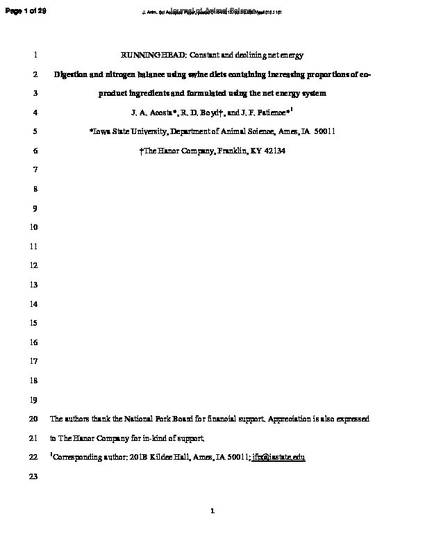
Rising feed expenditures demand that our industry pursues strategies to lower the cost of production. One option is the adoption of the net energy system (NE), although many producers are hesitant to proceed without proof that NE estimates are reliable. The objective of this experiment was to compare the apparent total tract digestibility (ATTD) of energy and nutrients and the N retention (NR) of diets formulated using the NE system with increasing quantities of co-product ingredients. The 5 dietary treatments included a control corn-soybean meal diet (CTL), the CTL diet plus 6% each of corn distiller’s dried grains with solubles (DDGS), corn germ meal, and wheat middlings, and NE equal to the CTL diet by adding soybean oil (CONS- 18), the CONS-18 diet, without oil added, with NE content lower than CTL (DECL-18), CTL plus 12% each of corn DDGS, corn germ meal, and wheat middlings, and NE equal to CTL by adding soybean oil (CONS-36), the CONS-36, without oil added, with NE content lower than the CTL diet (DECL-36). Diets were formulated for both growing (40 to 70 kg; GP) and finishing (70 to 110 kg; FP) periods. Forty gilts (PIC 337 × C22 or C29; initial BW=38.5 ± 0.4 kg) were randomly assigned to treatment and received feed and water ad-libitum (8 pigs per treatment). For the last 13 d of the GP and FP, pigs were transferred to metabolism crates, where two total urine and fecal collections (d 4 to 6; d 11 to 13) were performed. The GP fed diets with coproduct ingredients had lower ATTD of DM, N and GE than those fed the CTL diet (P < 0.050). The ATTD of N and GE decreased progressively as co-product inclusion increased from 0 to 18 to 36% in the FP (P < 0.010). In the GP and FP, there were no differences in ATTD of DM, N or GE between the pairs of CONS and DECL-NE treatments (P > 0.050). The NR declined on all co-product diets on the GP (P = 0.010) and tended to decline in the FP (P = 0.079). There were no differences in NR between CONS and DECL diets with the same level of co-product inclusion (P > 0.050). In conclusion, digestion of diets containing up to 36% co-products and formulated using NE resulted in expected DE and ME values; NR of diets with coproducts was lower than on the simple corn-soybean meal CTL diet, which is not related to the accuracy of the energy estimations, but rather to other factors such as imbalances in the AA concentrations or to post-absorptive energy metabolism, factors not accounted by the current energy systems approach.
Available at: http://works.bepress.com/john-patience/103/

This is a manuscript of an article published as Acosta, J. A., R. D. Boyd, and J. F. Patience. "Digestion and nitrogen balance using swine diets containing increasing proportions of coproduct ingredients and formulated using the net energy system." Journal of animal science 95, no. 3 (2017): 1243-1252. doi:10.2527/jas.2016.1161. Posted with permission.